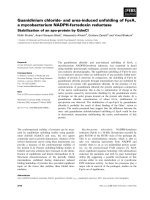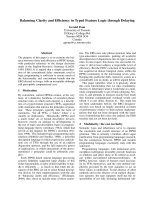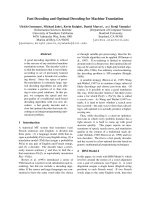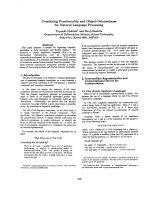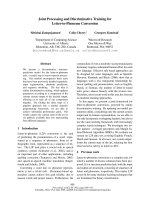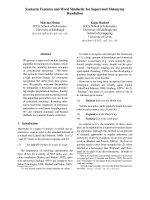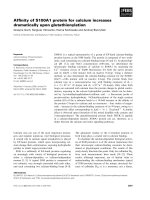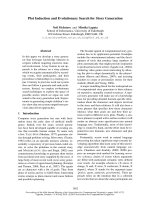Báo cáo khoa học: "Simultaneous Tokenization and Part-of-Speech Tagging for Arabic without a Morphological Analyzer" doc
Bạn đang xem bản rút gọn của tài liệu. Xem và tải ngay bản đầy đủ của tài liệu tại đây (114.3 KB, 6 trang )
Proceedings of the ACL 2010 Conference Short Papers, pages 342–347,
Uppsala, Sweden, 11-16 July 2010.
c
2010 Association for Computational Linguistics
Simultaneous Tokenization and Part-of-Speech Tagging for Arabic
without a Morphological Analyzer
Seth Kulick
Linguistic Data Consortium
University of Pennsylvania
Abstract
We describe an approach to simultaneous
tokenization and part-of-speech tagging
that is based on separating the closed and
open-class items, and focusing on the like-
lihood of the possible stems of the open-
class words. By encoding some basic lin-
guistic information, the machine learning
task is simplified, while achieving state-
of-the-art tokenization results and compet-
itive POS results, although with a reduced
tag set and some evaluation difficulties.
1 Introduction
Research on the problem of morphological disam-
biguation of Arabic has noted that techniques de-
veloped for lexical disambiguation in English do
not easily transfer over, since the affixation present
in Arabic creates a very different tag set than for
English, in terms of the number and complexity
of tags. In additional to inflectional morphology,
the POS tags encode more complex tokenization
sequences, such as preposition + noun or noun +
possessive pronoun.
One approach taken to this problem is to use
a morphological analyzer such as BAMA-v2.0
(Buckwalter, 2004) or SAMA-v3.1 (Maamouri et
al., 2009c)
1
, which generates a list of all possi-
ble morphological analyses for a given token. Ma-
chine learning approaches can model separate as-
pects of a solution (e.g., “has a pronominal clitic”)
and then combine them to select the most appro-
priate solution from among this list. A benefit
of this approach is that by picking a single solu-
tion from the morphological analyzer, the part-of-
speech and tokenization comes as a unit (Habash
and Rambow, 2005; Roth et al., 2008).
1
SAMA-v3.1 is an updated version of BAMA, with many
significant differences in analysis.
In contrast, other approaches have used a
pipelined approach, with separate models to first
do tokenization and then part-of-speech tagging
(Diab et al., 2007; Diab, 2009). While these ap-
proaches have somewhat lower performance than
the joint approach, they have the advantage that
they do not rely on the presence of a full-blown
morphological analyzer, which may not always be
available or appropriate as the data shifts to differ-
ent genres or Arabic dialects.
In this work we present a novel approach to
this problem that allows us to do simultaneous to-
kenization and core part-of-speech tagging with
a simple classifier, without using a full-blown
morphological analyzer. We distinguish between
closed-class and open-class categories of words,
and encode regular expressions that express the
morphological patterns for the former, and simple
regular expressions for the latter that provide only
the generic templates for affixation. We find that a
simple baseline for the closed-class words already
works very well, and for the open-class words we
classify only the possible stems for all such ex-
pressions. This is however sufficient for tokeniza-
tion and core POS tagging, since the stem identi-
fies the appropriate regular expression, which then
in turn makes explicit, simultaneously, the tok-
enization and part-of-speech information.
2 Background
The Arabic Treebank (ATB) contains a full mor-
phological analysis of each “source token”, a
whitespace/punctuation-delimited string from the
source text. The SAMA analysis includes four
fields, as shown in the first part of Table 1.
2
TEXT
is the actual source token text, to be analyzed. VOC
is the vocalized form, including diacritics. Each
VOC segment has associated with it a POS tag and
2
This is the analysis for one particular instance of ktbh.
The same source token may receive another analysis else-
where in the treebank.
342
ATB analysis for one source token:
TEXT: ktbh
VOC: kutub u hu
POS: NOUN CASE NOM POSS PRON 3MS
GLOSS: books [def.nom.] its/his
Results in two ATB tree tokens:
TEXT: ktb h
VOC: kutub+u hu
POS: NOUN+CASE NOM POSS PRON 3MS
Current work recovers:
TEXT: ktb h
POS: NOA POSS PRON
Table 1: Example analysis of one source token
NOUN, ADJ, NOUN.VN, NOA
ADJ.VN, NOUN NUM, ADJ NUM, (Noun or
NOUN QUANT, ADJ COMP, ABBREV Adjective)
IV, IV PASS IV
PV, PV PASS PV
IVSUFF DO, PVSUFF DO OBJ PRON
Table 2: Collapsing of ATB core tags into reduced
core tags
GLOSS. While “tokenization” can be done in dif-
ferent ways on top of this analysis, the ATB splits
the VOC/POS/GLOSS segments up based on the
POS tags to form the “tree tokens” necessary for
treebanking. As shown in the second part of Table
1, the first two segments remain together as one
tree token, and the pronoun is separated as a sep-
arate tree token. In addition, the input TEXT is
separated among the two tree tokens.
3
Each tree token’s POS tag therefore consists
of what can be considered an “ATB core tag”,
together with inflectional material (case, gender,
number). For example, in Table 1, the “core tag”
of the first tree token is NOUN. In this work, we aim
to recover the separation of a source token TEXT
into the corresponding separate tree token TEXTs,
together with a “reduced core tag” for each tree to-
ken. By “reduced core tag”, we mean an ATB core
tag that has been reduced in two ways:
(1) All inflectional material [infl] is stripped
off six ATB core tags: PRON[infl], POSS PRON[infl],
DEM[infl], [IV|PV|CV]SUFF DO[infl]
(2) Collapsing of some ATB core tags, as listed
in Table 2.
These two steps result in a total of 40 reduced
core tags, and each tree token has exactly one such
reduced core tag. We work with the ATB3-v3.2 re-
lease of the ATB (Maamouri et al., 2009b), which
3
See (Kulick et al., 2010) for a detailed discussion of
how this splitting is done and how the tree token TEXT field
(called INPUT STRING in the ATB releases) is created.
NOA 173938 PART 288
PREP 49894 RESTRIC PART 237
PUNC 41398 DET 215
NOUN PROP 29423 RC PART 192
CONJ 28257 FOCUS PART 191
PV 16669 TYPO 188
IV 15361 INTERROG PART 187
POSS PRON 9830 INTERROG ADV 169
SUB CONJ 8200 INTERROG PRON 112
PRON 6995 CV 106
REL PRON 5647 VOC PART 74
DEM 3673 VERB 62
OBJ PRON 2812 JUS PART 56
NEG PART 2649 FOREIGN 46
PSEUDO VERB 1505 DIALECT 41
FUT PART 1099 INTERJ 37
ADV 1058 EMPHATIC PART 19
VERB PART 824 CVSUFF DO 15
REL ADV 414 GRAMMAR PROB 4
CONNEC PART 405 LATIN 1
Table 3: The 40 “reduced core tags”, and their fre-
quencies in ATB3-v3.2. The total count is 402291,
which is the number of tree tokens in ATB3-v3.2.
has 339710 source tokens and 402291 tree tokens,
where the latter are derived from the former as dis-
cussed above. Table 3 lists the 40 reduced tags
we use, and their frequency among the ATB3-v3.2
tree tokens.
3 Description of Approach
Given a source token, we wish to recover (1) the
tree tokens (which amounts to recovering the ATB
tokenization), and (2) the reduced core POS tag for
each tree token. For example, in Table 1, given the
input source token TEXT ktbh, we wish to recover
the tree tokens ktb/NOA and h/POSS PRON.
As mentioned in the introduction, we use reg-
ular expressions that encode all the tokenization
and POS tag possibilities. Each “group” (substring
unit) in a regular expression (regex) is assigned an
internal name, and a list is maintained of the pos-
sible reduced core POS tags that can occur with
that regex group. It is possible, and indeed usu-
ally the case for groups representing affixes, that
more than one such POS tag is possible. How-
ever, it is crucial for our approach that while some
given source token TEXT may match many regu-
lar expressions (regexes), when the POS tag is also
taken into account, there can be only one match
among all the (open or closed-class) regexes. We
say a source token “pos-matches” a regex if the
TEXT matches and POS tags match, and “text-
matches” if the TEXT matches the regex regard-
less of the POS. During training, the pos-matching
343
(REGEX #1) [w|f]lm
w: [PART, CONJ, SUB CONJ, PREP]
f: [CONJ, SUB CONJ, CONNEC PART, RC PART]
lm: [NEG PART]
(REGEX #2) [w|f]lm
w: and f: same as above
lm: [REL ADV,INTERROG ADV]
Figure 1: Two sample closed-class regexes
regex for a source token TEXT is stored as the
gold solution for closed-class patterns, or used to
create the gold label for the open-class classifier.
We consider the open-class tags in Table 3 to be:
NOUN PROP, NOA, IV, CV, PV, VERB. A source
token is considered to have an open-class solution
if any of the tree tokens in that solution have an
open-class tag. For example, ktbh in Table 1 has
an open-class solution because one of the tree to-
kens has an open-class tag (NOA), even though the
other is closed-class (POSS PRON).
We encode the possible solutions for closed-
class source tokens using the lists in the ATB mor-
phological guidelines (Maamouri et al., 2009a).
For example, Figure 1 shows two of the closed-
class regexes. The text wlm can text-match either
REGEX #1 or #2, but when the POS tag for lm is
taken into account, only one can pos-match. We
return to the closed-class regexes in Section 4.
We also encode regular expression for the open-
class source tokens, but these are simply generic
templates expressing the usual affix possibilities,
such as:
[wf] [blk] stem NOA poss pronoun
where there is no list of possible strings for
stem_NOA, but which instead can match any-
thing. While all parts except for the stem are op-
tional, we do not make such parts optional in a
single expression. Instead, we multiple out the
possibilities into different expressions with differ-
ent parts (e.g., [wf]) being obligatory). The reason
for this is that we give different names to the stem
in each case, and this is the basis of the features
for the classifier. As with the closed-class regexes,
we associate a list of possible POS tags for each
named group within a regular expression. Here
the stem NOA group can only have the tag NOA.
We create features for a classifier for the open-
class words as follows. Each word is run through
all of the open-class regular expressions. For each
expression that text-matches, we make a feature
which is the name of the stem part of the regular
expression, along with the characters that match
the stem. The stem name encodes whether there
is a prefix or suffix, but does not include a POS
tag. However, the source token pos-matches ex-
actly one of the regular expressions, and the pos
tag for the stem is appended to the named stem for
that expression to form the gold label for training
and the target for testing.
For example, Table 4 lists the matching regular
expression for three words. The first, yjry, text-
matches the generic regular expressions for any
string/NOA, any string/IV, etc. These are sum-
marized in one listing, yjry/all. The name of the
stem for all these expressions is the same, just
stem, and so they all give rise to the same feature,
stem=yjry. It also matches the expression for
a NOA with a possessive pronoun
4
, and in this
case the stem name in the regular expression is
stem_spp (which stands for “stem with a pos-
sessive pronoun suffix”), and this gives rise to the
feature stem_spp=yjr. Similarly, for wAfAdt
the stem of the second expression has the name
p_stem, for a prefix. The third example shows
the different stem names that occur when there are
both prefix and suffix possibilities. For each exam-
ple, there is exactly one regex that not only text-
matches, but also pos-matches. The combination
of the stem name in these cases together with the
gold tag forms the gold label, as indicated in col-
umn 3.
Therefore, for each source token TEXT, the
features include the ones arising from the named
stems of all the regexes that text-match that TEXT,
as shown in column 4, and the gold label is the
appropriate stem name together with the POS
tag, as shown in column 3. We also include
some typical features for each stem, such as first
and last two letters of each stem, etc. For ex-
ample, wAfAdt would also have the features
stem_fl=w, p_stem_fl=A, indicating that the
first letter of stem is w and the first letter of
p_stem is A. We also extract a list of proper
nouns from SAMA-v3.1 as a temporary proxy for
a named entity list, and include a feature for a
stem if that stem is in the list (stem_in_list,
p_stem_in_list, etc.)
We do not model separate classifiers for prefix
possibilities. There is a dependency between the
4
The regex listed is slightly simplified. It actually con-
tains a reference to the list of all possessive pronouns, not
just y.
344
source TEXT text-matching regular expressions gold label feature
yjry yjry/all (happens) stem:IV stem=yjry
yjr/NOA+y/POSS PRON stem spp=yjr
wAfAdt wAfAdt/all stem=wAfAdt
w + AfAdt/all (and+reported) p stem:PV p stem=AfAdt
lAstyDAHhm lAstyDAHhm/all stem=lAstyDAHhm
l/PREP + AstyDAHhm/NOA p stem=AstyDAHhm
l/PREP + AstyDAH/NOA + hm/POSS PRON p stem spp:NOA p stem spp=AstyDAH
for + request for clarification + their
lAstyDAH/NOA + hm/POSS PRON stem spp=lAstyDAH
lAstyDAH/IV,PV,CV + hm/OBJ PRON stem svop=lAstyDAH
l/PREP,JUS PART + AstyDAH/IV,PV,CV + p stem svop=AstyDAH
hm/OBJ PRON
Table 4: Example features and gold labels for three words. Each text-matching regex gives rise to one
feature shown in column 4, based on the stem of that regular expression. A p before a stem means that
it has a prefix, spp after means that it has a possessive pronouns suffix, and svop means that it has
a (verbal) object pronoun suffix. “all” in the matching regular expression is shorthand for text-matching
all the corresponding regular expressions with NOA, IV, etc. For each word, exactly one regex also
pos-matches, which results in the gold label, shown in column 3.
possibility of a prefix and the likelihood of the re-
maining stem, and so we focus on the likelihood of
the possible stems, where the open-class regexes
enumerate the possible stems. A gold label to-
gether with the source token TEXT maps back to
a single regex, and so for a given label, the TEXT
is parsed by that regular expression, resulting in a
tokenization along with list of possible POS tags
for each affix group in the regex.
5
During training and testing, we run each word
through all the open and closed regexes. Text-
matches for an open-class regex give rise to fea-
tures as just described. Also, if the word matches
any closed-class regex, it receives the feature
MATCHES CLOSED. During training, if the cor-
rect match for the word is one of the closed-class
expressions, then the gold label is CLOSED. The
classifier is used only to get solutions for the open-
class words, although we wish to give the classifier
all the words for the sentence. The cross-product
of the stem name and (open-class) reduced core
POS tags, plus the CLOSED tag, yields 24 labels
for a CRF classifier in Mallet (McCallum, 2002).
4 Experiments and Evaluation
We worked with ATB3-v3.2, following the train-
ing/devtest split in (Roth et al., 2008) on a pre-
vious release of the same data. We keep a list-
ing (List #1) of all (source token TEXT, solution)
pairs seen during training. For an open-class so-
lution, “solution” is the gold label as described in
5
In Section 4 we discuss how these are narrowed down to
one POS tag.
Section 3. For a closed-class solution, “solution”
is the name of the single pos-matching regex. In
addition, for every regex seen during training that
pos-matches some source token TEXT, we keep a
listing (List #2) of all ((regex-group-name, text),
POS-tag) tuples. We use the information in List
#1 to choose a solution for all words seen in train-
ing in the Baseline and Run 2 below, and in Run
3, for words text-matching a closed-class expres-
sion. We use List #2 to disambiguate all remain-
ing cases of POS ambiguity, wherever a solution
comes from.
For example, if wlm is seen during testing, List
#1 will be consulted to find the most common so-
lution (REGEX #1 or #2), and in either case, List
#2 will be consulted to determine the most fre-
quent tag for w as a prefix. While there is certainly
room for improvement here, this works quite well
since the tags for the affixes do not vary much.
We score the solution for a source token in-
stance as correct for tokenization if it exactly
matches the TEXT split for the tree tokens derived
from that source token instance in the ATB. It is
correct for POS if correct for tokenization and if
each tree token has the same POS tag as the re-
duced core tag for that tree token in the ATB.
For a simple baseline, if a source token TEXT
is in List #1 then we simply use the most fre-
quent stored solution. Otherwise we run the TEXT
through all the regexes. If it text-matches any
closed-class expression, we pick a random choice
from among those regexes and otherwise from the
open-class regexes that it text-matches. Any POS
ambiguities for a regex group are disambiguated
345
Solution Baseline Run 2 Run 3
Origin # tokens Tok POS # tokens Tok POS # tokens Tok POS
All 51664 96.0% 87.4% 51664 99.4% 95.1% 51664 99.3% 95.1%
Stored 46072 99.8% 96.6% 46072 99.8% 96.6% 16145 99.6% 96.4%
Open 5565 64.6% 11.6% 10 10.0% 0.0% 11 54.5% 0.0%
Closed 27 81.5% 59.3% 27 81.5% 63.0% 27 81.5% 63.0%
Mallet 0 5555 96.0% 83.8% 35481 99.1% 94.5%
Table 5: Results for Baseline and two runs. Origin “stored” means that the appropriate regex came from
the list stored during training. Origins “open” and “closed” are random choices from the open or closed
regexes for the source token. “Mallet” means that it comes from the label output by the CRF classifier.
using List #2, as discussed above. The results
are shown in Table 5. The score is very high for
the words seen during training, but much lower
for open-class words that were not. As expected,
almost all (except 27) instances of closed-class
words were seen during training.
For run 2, we continue to use the stored solution
if the token was seen in training. If not, then if the
TEXT matches one or more closed-class regexes,
we randomly choose one. Otherwise, if the CRF
classifier has produced an open-class match for
that token, we use that (and otherwise, in only 10
cases, use a random open-class match). There is a
significant improvement in the score for the open-
class items, and therefore in the overall results.
For run 3, we put more of a burden on the clas-
sifier. If a word matches any closed-class expres-
sion, we either use the most frequent occurence
during training (if it was seen), or use a random
maching closed-class expression (if not). If the
word doesn’t match a closed-class expression, we
use the mallet result. The mallet score goes up, al-
most certainly because the score is now including
results on words that were seen during training.
The overall POS result for run 3 is slightly less
than run 2. (95.099% compared to 95.147%).
It is not a simple matter to compare results with
previous work, due to differing evaluation tech-
niques, data sets, and POS tag sets. With differ-
ent data sets and training sizes, Habash and Ram-
bow (2005) report 99.3% word accuracy on tok-
enization, and Diab et al. (2007) reports a score
of 99.1%. Habash and Rambow (2005) reported
97.6% on the LDC-supplied reduced tag set, and
Diab et al. (2007) reported 96.6%. The LDC-
supplied tag set used is smaller than the one in
this paper (24 tags), but does distinguish between
NOUN and ADJ. However, both (Habash and
Rambow, 2005; Diab et al., 2007) assume gold
tokenization for evaluation of POS results, which
we do not. The “MorphPOS” task in (Roth et al.,
2008), 96.4%, is somewhat similar to ours in that
it scores on a “core tag”, but unlike for us there is
only one such tag for a source token (easier) but it
distinguishes between NOUN and ADJ (harder).
We would like to do a direct comparison by sim-
ply runing the above systems on the exact same
data and evaluating them the same way. However,
this unfortunately has to wait until new versions
are released that work with the current version of
the SAMA morphological analyzer and ATB.
5 Future Work
Obvious future work starts with the need to in-
clude determiner information in the POS tags and
the important NOUN/ADJ distinction. There are
various possibilities for recovering this informa-
tion, such as (1) using a different module combin-
ing NOUN/ADJ disambiguation together with NP
chunking, or (2) simply including NOUN/ADJ in
the current classifier instead of NOA. We will be
implementing and comparing these alternatives.
We also will be using this system as a preprocess-
ing step for a parser, as part of a complete Arabic
NLP pipeline.
Acknowledgements
We thank Ann Bies, David Graff, Nizar Habash,
Mohamed Maamouri, and Mitch Marcus for
helpful discussions and comments. This work
was supported by the Defense Advanced Re-
search Projects Agency, GALE Program Grant
No. HR0011-06-1-0003 and by the GALE pro-
gram, DARPA/CMO Contract No. HR0011-06-
C-0022. The content of this paper does not nec-
essarily reflect the position or the policy of the
Government, and no official endorsement should
be inferred.
346
References
Tim Buckwalter. 2004. Buckwalter Arabic morpho-
logical analyzer version 2.0. Linguistic Data Con-
sortium LDC2004L02.
Mona Diab, Kadri Hacioglu, and Daniel Jurafsky.
2007. Automatic processing of Modern Standard
Arabic text. In Abdelhadi Soudi, Antal van den
Bosch, and Gunter Neumann, editors, Arabic Com-
putational Morphology, pages 159–179. Springer.
Mona Diab. 2009. Second generation tools (AMIRA
2.0): Fast and robust tokenization, pos tagging, and
base phrase chunking. In Proceedings of 2nd Inter-
national Conference on Arabic Language Resources
and Tools (MEDAR), Cairo, Egypt, April.
Nizar Habash and Owen Rambow. 2005. Arabic to-
kenization, part-of-speech tagging and morphologi-
cal disambiguation in one fell swoop. In Proceed-
ings of the 43rd Annual Meeting of the Association
for Computational Linguistics (ACL’05), pages 573–
580, Ann Arbor, Michigan, June. Association for
Computational Linguistics.
Seth Kulick, Ann Bies, and Mohamed Maamouri.
2010. Consistent and flexible integration of mor-
phological annotation in the Arabic Treebank. In
Language Resources and Evaluation (LREC).
Mohamed Maamouri, Ann Bies, Sondos Krouna,
Fatma Gaddeche, Basma Bouziri, Seth Kulick, Wig-
dane Mekki, and Tim Buckwalter. 2009a. Arabic
Treebank Morphological and Syntactic guidelines,
July. />Mohamed Maamouri, Ann Bies, Seth Kulick, Sondos
Krouna, Fatma Gaddeche, and Wajdi Zaghouani.
2009b. Arabic treebank part 3 - v3.2. Linguistic
Data Consortium LDC2010T08, April.
Mohammed Maamouri, Basma Bouziri, Sondos
Krouna, David Graff, Seth Kulick, and Tim Buck-
walter. 2009c. Standard Arabic morphological ana-
lyzer (SAMA) version 3.1. Linguistic Data Consor-
tium LDC2009E73.
Andrew McCallum. 2002. Mallet: A machine learning
for language toolkit. .
Ryan Roth, Owen Rambow, Nizar Habash, Mona Diab,
and Cynthia Rudin. 2008. Arabic morphologi-
cal tagging, diacritization, and lemmatization using
lexeme models and feature ranking. In Proceed-
ings of ACL-08: HLT, Short Papers, pages 117–120,
Columbus, Ohio, June. Association for Computa-
tional Linguistics.
347

